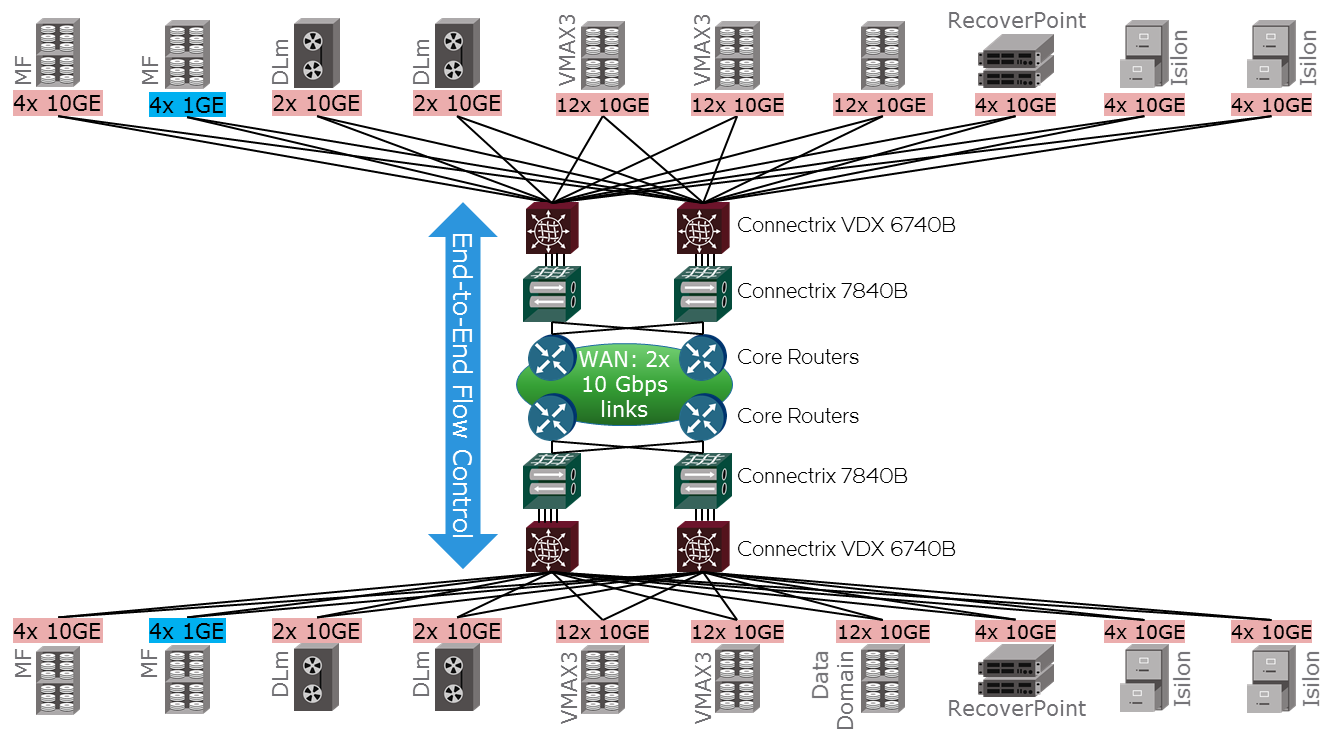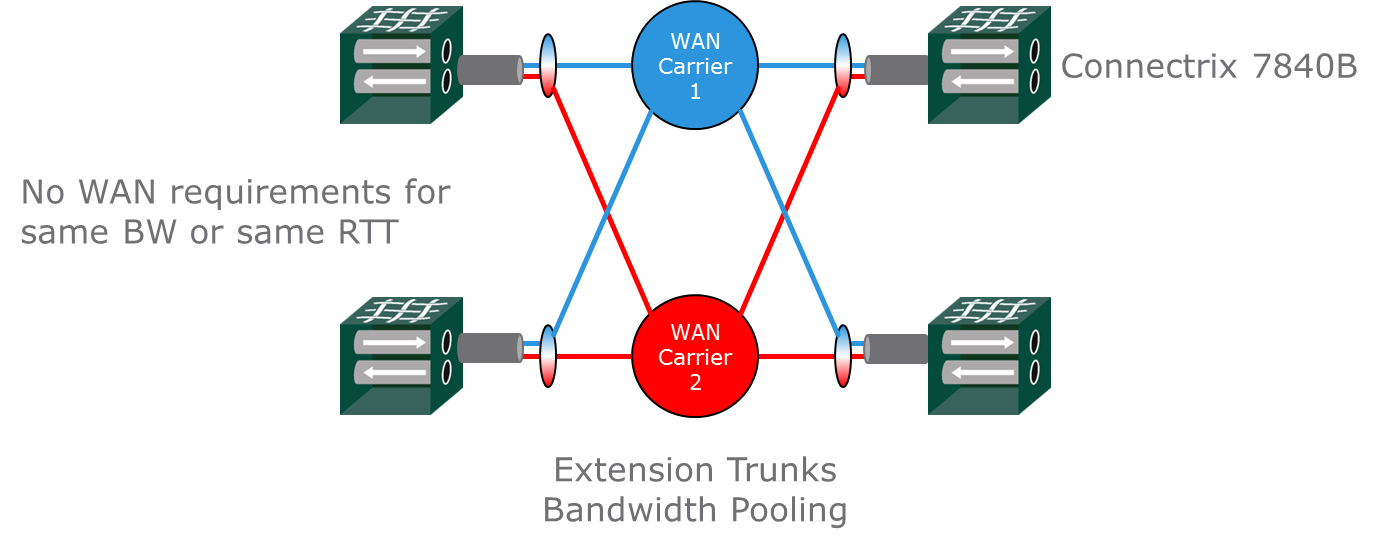This is IPEX Blog 2 of 3
@EXTENSION_GURU
Viva Las Vegas! Have you checked out the Brocade booth yet! Consistently every year, so awesome! Clearly, Brocade Engineering has been busy. Today, I have a couple more IPEX use cases to consider – Link Aggregation and Bandwidth Pooling/Balance.
If you haven’t yet seen yesterday’s blog post, please check it out. Also, attend my breakout session entitled,
“Storage over Distance from SRDF to SyncIQ” to learn more about IPEX for your environment.
We’ll be in Deflino 4001A at 8:30 AM.
Before we get to today's use cases, I want to make sure you know that the Connectrix VDX-6740B is an integral part of the IPEX solution (7840+6740). The video below talks more about the Connectrix VDX-6740B IP Storage Switch...
There are 3 reasons why the Connectrix VDX-6740B is part of the IPEX solution:
- To add more Ethernet interfaces, the Connectrix 7840B in Hybrid mode has only 8 GE/10GE interfaces available for LAN side connections. A LAG (Link Aggregation) between the two binds them together.
- The Connectrix 7840B is not an Ethernet switch or router. Once traffic goes in, it is delivered to the remote side or dropped based on the Traffic Control List. Traffic cannot hairpin and come back out preventing loops without the need for complex network protocols. The Connectrix 6740B provides Ethernet switching enabling connected devices to communicate within the local data center.
- A wholisticly supported solution by both EMC and Brocade.
Use Case 3: Link Aggregation
There are environments that have many Ethernet connections coming from a multitude of devices as shown in the diagram below. Aggregating all these links into a limited amount of WAN bandwidth results in oversubscription of WAN bandwidth apportioned to storage. Oversubscription can lead to periods of intermittent congestion. Congestion often results in packet loss due to buffer overflow. Packet loss causes the native TCP stacks on IP storage devices to slow-down dramatically. Dramatically slowing down throughput does clear congestion but results in severely poor replication performance. Native IP stacks have no tolerance for any packet loss while maintaining replication throughput performance. In an IP network in which end-to-end flow-control doesn’t exist, this condition oscillates endlessly for as long as there is more data than the WAN can accommodate. This condition is prevented with Connectrix 7840B IPEX.

Below is nearly the same diagram except Connectrix 7840B IPEX have been added. Now, the TCP sessions originating and terminating on the IP storage devices are flow-controlled. Before packet loss due to congestion occurs, IPEX flow-control will slow or halt the source of incoming IP storage data. From the view point of the IP storage devices, no packet loss maintains maximum throughput to the local Connectrix 7840B. With IPEX, the aggregation of many flows across limited bandwidth results in all the IP storage flows playing nice with each other, i.e., they don’t fight each other for bandwidth. End to end flow-control achieves optimal throughput for all the devices given the amount of available bandwidth.

Lastly, in an IP storage environment in which you are adding a variety of devices such as depicted here, using the Connectrix 6740B IP Storage Switch allows Storage Admins to add/remove devices to their backend IP storage network at will. Add new devices quickly and easily with the reassurance that WAN congestion will not be the result. Transport of your tunnel across the WAN is left to the network guys, however, what goes in that tunnel is determined by the storage team.
Use Case 4: Bandwidth Pooling & Balance
Bandwidth Pooling is the ability to pool together multiple WAN connections into a single logical WAN. Balance is the ability, at a granular level, to load balance across various WAN connections and be completely transparent to the IP storage devices.
You may use multiple WAN carriers and connections to transport IP storage between data centers. This provides redundancy in the event a carrier has an outage. The trick is to make the WAN connections appear as a single logical WAN. This is done in a variety of ways and network admins have their typical methods, which often have significant shortcomings. The Connectrix 7840B has Extension Trunking, which provides the following benefits when creating a single logical WAN from multiple connections:
- Aggregation of bandwidth from multiple WAN connections
- No requirement for equal bandwidth connections
- No requirement for equal latency connections
- Near perfect weighted balance of data across all circuits of a tunnel
- In-order delivery guarantee for all data through multiple circuits of a tunnel
- No lost data in-flight, even when a WAN connection is lost
- Lossless automated failover and failback of circuits within a tunnel
- Reduced complexity, no need for Port Channeling or VRRP (Virtual Router Redundancy Protocol)

If your environment has multiple distinctly separate connections and you wish to benefit from the functions listed above, EMC Connectrix 7840B provides Bandwidth Pooling and Balance across your WAN infrastructure.
OK, that’s it for today. Please look for Wednesday’s post where I’ll touch on one more of the many IPEX use cases.
Be good!
#7840#Balance#BrocadeFibreChannelNetworkingCommunity#IPEX#EMCWorld#aggregation#extension